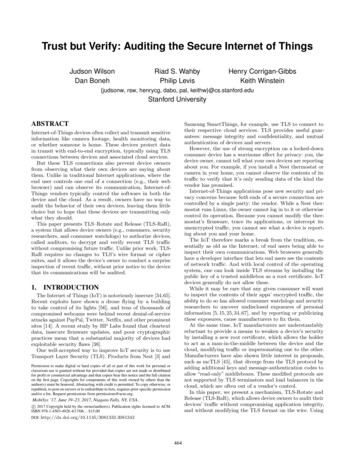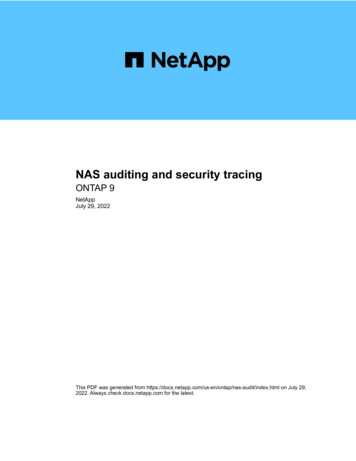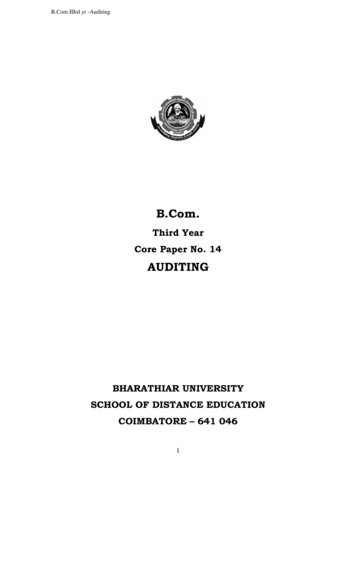
Transcription
Trust but Verify: Auditing the Secure Internet of ThingsJudson WilsonDan BonehRiad S. WahbyPhilip LevisHenry Corrigan-GibbsKeith Winstein{judsonw, rsw, henrycg, dabo, pal, keithw}@cs.stanford.eduStanford UniversityABSTRACTSamsung SmartThings, for example, use TLS to connect totheir respective cloud services. TLS provides useful guarantees: message integrity and confidentiality, and mutualauthentication of devices and servers.However, the use of strong encryption on a locked-downconsumer device has a worrisome effect for privacy: you, thedevice owner, cannot tell what your own devices are reportingabout you. For example, if you install a Nest thermostat orcamera in your home, you cannot observe the contents of itstraffic to verify that it’s only sending data of the kind thevendor has promised.Internet-of-Things applications pose new security and privacy concerns because both ends of a secure connection arecontrolled by a single party: the vendor. While a Nest thermostat runs Linux, the owner cannot log in to it or otherwisecontrol its operation. Because you cannot modify the thermostat’s firmware, trace its applications, or intercept itsunencrypted traffic, you cannot see what a device is reporting about you and your home.The IoT therefore marks a break from the tradition, essentially as old as the Internet, of end users being able toinspect their own communications. Web browsers generallyhave a developer interface that lets end users see the contentsof network traffic. And with local control of the operatingsystem, one can look inside TLS streams by installing thepublic key of a trusted middlebox as a root certificate. IoTdevices generally do not allow these.While it may be rare that any given consumer will wantto inspect the contents of their apps’ encrypted traffic, theability to do so has allowed consumer watchdogs and securityresearchers to uncover undisclosed exposures of personalinformation [5, 15, 25, 34, 67], and by reporting or publicizingthese exposures, cause manufacturers to fix them.At the same time, IoT manufacturers are understandablyreluctant to provide a means to weaken a device’s securityby installing a new root certificate, which allows the holderto act as a man-in-the-middle between the device and thecloud, modifying traffic or impersonating one to the other.Manufacturers have also shown little interest in proposals,such as mcTLS [45], that diverge from the TLS protocol byadding additional keys and message-authentication codes toallow “read-only” middleboxes. These modified protocols arenot supported by TLS terminators and load balancers in thecloud, which are often out of a vendor’s control.In this paper, we present a mechanism, TLS-Rotate andRelease (TLS-RaR), which allows device owners to audit theirdevices’ traffic without compromising application integrity,and without modifying the TLS format on the wire. UsingInternet-of-Things devices often collect and transmit sensitiveinformation like camera footage, health monitoring data,or whether someone is home. These devices protect datain transit with end-to-end encryption, typically using TLSconnections between devices and associated cloud services.But these TLS connections also prevent device ownersfrom observing what their own devices are saying aboutthem. Unlike in traditional Internet applications, where theend user controls one end of a connection (e.g., their webbrowser) and can observe its communication, Internet-ofThings vendors typically control the software in both thedevice and the cloud. As a result, owners have no way toaudit the behavior of their own devices, leaving them littlechoice but to hope that these devices are transmitting onlywhat they should.This paper presents TLS–Rotate and Release (TLS-RaR),a system that allows device owners (e.g., consumers, securityresearchers, and consumer watchdogs) to authorize devices,called auditors, to decrypt and verify recent TLS trafficwithout compromising future traffic. Unlike prior work, TLSRaR requires no changes to TLS’s wire format or ciphersuites, and it allows the device’s owner to conduct a surpriseinspection of recent traffic, without prior notice to the devicethat its communications will be audited.1.INTRODUCTIONThe Internet of Things (IoT) is notoriously insecure [34,65].Recent exploits have shown a drone flying by a buildingto take control of its lights [56], and tens of thousands ofcompromised webcams were behind recent denial-of-serviceattacks against PayPal, Twitter, Netflix, and other prominentsites [14]. A recent study by HP Labs found that cleartextdata, insecure firmware updates, and poor cryptographicpractices mean that a substantial majority of devices hadexploitable security flaws [38].One well-accepted way to improve IoT security is to useTransport Layer Security (TLS). Products from Nest [3] andPermission to make digital or hard copies of all or part of this work for personal orclassroom use is granted without fee provided that copies are not made or distributedfor profit or commercial advantage and that copies bear this notice and the full citationon the first page. Copyrights for components of this work owned by others than theauthor(s) must be honored. Abstracting with credit is permitted. To copy otherwise, orrepublish, to post on servers or to redistribute to lists, requires prior specific permissionand/or a fee. Request permissions from permissions@acm.org.MobiSys ’17, June 19–23, 2017, Niagara Falls, NY, USA.c 2017 Copyright held by the owner/author(s). Publication rights licensed to ACM.ISBN 978-1-4503-4928-4/17/06. . . 15.00DOI: http://dx.doi.org/10.1145/3081333.3081342464
TLS-RaR, TLS connections between an IoT device and thecloud retain their end-to-end integrity and remain encryptedas before, but an owner can optionally install any number ofread-only, in-home auditors, low-cost devices on the owner’shome network that passively sniff the ciphertext of TLSsessions.TLS-RaR’s key idea is that at any moment, the user canlog in to the cloud service and instruct the device to rotatea TLS connection’s symmetric encryption keys. Once thedevice is certain that both it and the server will no longeruse the old keys, it securely releases the superseded keys tothe user or the user’s designated auditor. Using these keys,the auditor decrypts and verifies its cache of past ciphertext.As a result, the auditor receives delayed access to the samesession keys as the TLS endpoints, and therefore the sameintegrity-protected plaintext, even from before the endpointswere informed about the auditor’s existence; but the auditorcannot forge data or masquerade as either party.Compared with approaches like mcTLS, TLS-RaR is simpler and more deployable. TLS-RaR requires no modificationsto TLS’s wire format, state machines, or the server-side TLSendpoint. This last point is beneficial because large-scaleTLS deployments often offload server-side TLS terminationto middleboxes or specialized hardware. Changing TLS software or hardware on the server side is difficult, and existingsystems may be architected such that the TLS and application layers are independent. We found (§5.3) that TLS-RaRcan already be used today with most TLS servers in the wild.TLS-RaR differs in other respects from previous proposalsto audit encrypted communications. It works with passiveauditors that do not have to act as men-in-the-middle. Auditors are guaranteed to see the same payloads and performthe same integrity checks as the TLS endpoints. Endpointscannot send a different stream to auditors than they do toeach other, in order to conceal malicious traffic. Multipleauditors can observe encrypted streams in parallel, withoutbeing able to confuse one another.TLS-RaR also carries major limitations. First, auditorsonly learn the plaintext after some delay. TLS-RaR cannot beused to detect and prevent compromise in real time. Second,TLS-RaR simply allows an auditor to see inside the encryptedstream provided by TLS. TLS-RaR does not, by itself, detector defeat additional layers of encryption or covert channelswithin a TLS stream. Finally, TLS-RaR of course requires thevendor’s cooperation. Manufacturers who are not interestedin subjecting their devices’ communications to independentaudits are unlikely to implement TLS-RaR.Nonetheless, we believe the benefits of IoT audits wouldbe considerable. We envision independent watchdogs (e.g.,Consumer Reporters, Underwriters Laboratories, securityfirms, independent researchers, and academics) purchasinga random sample of popular devices off the shelf, and usingTLS-RaR to verify that they communicate as they should.For example, Amazon states that its Alexa devices listento audio all the time, but only transmit recordings that aremade while the light is on (and shortly before the light turnedon) [1]. Is this statement true? Can it be independentlyverified, and monitored, as the software on these devicesis updated over time? We believe that IoT manufacturersought to welcome the idea of independent audits to verifythat their devices are communicating as advertised, just asthey allow financial auditors to inspect their warehousesand financial statements. In both cases, such audits buildconfidence and allow consumers or shareholders to separategood products—and companies—from bad ones.This paper makes these contributions:1. The design of TLS-RaR, including secure protocols forkey rotation and for key release.2. Measurements of TLS-RaR’s existing support across asurvey of popular websites.3. Measurements of the communications of 5 IoT devices.4. An evaluation of TLS-RaR’s effect on application traffic using an implementation of TLS-RaR based onOpenSSL 1.0.2 running on embedded hardware, andan auditor based on tshark.The rest of this paper is structured as follows. Section 2describes requirements for IoT auditing. Section 3 gives anoverview of TLS-RaR’s operating model and approach. Sections 4.1 and 4.2 present the TLS-RaR protocols for rotationand release, respectively. Section 5 evaluates TLS-RaR’scompatibility with existing servers, the performance of aprototype implementation, and the behavior of existing IoTdevices. An auditor may have significant ethical and surveillance implications; we discuss these in Section 6, and limitations of the approach in Section 7. Section 8 surveys relatedwork.2.AUDITING IOT DEVICESTLS-RaR’s goal is to enable auditing—after-the-fact inspection of traffic—without modifying TLS or giving auditorsman-in-the-middle access to encrypted channels. To that end,this section defines four requirements for a secure and practical IoT auditing system: past auditability, present-momentintegrity, audit robustness, and compatibility with TLS. Italso describes the threat model against which the securitynotions are defined, and discusses limitations.We use the following notation for a TLS session whendescribing these requirements. A TLS session uses a set ofsymmetric session keys for its ciphers; the number and size ofkeys is determined by the TLS cipher suite, which is chosenby the the client and server endpoints independent of theauditing system. We refer to keys and their lifetime in termsof epochs. In an epoch t, a client and server communicateusing session keys kt . TLS allows the client and server togenerate new keys, whereupon epoch t 1 begins. In practice,the client and server can generate new keys asynchronously,so the endpoints’ notions of the current epoch may differtransiently. This means that epochs are defined with respectto a sequence of TLS records rather than with respect towall-clock time.2.1RequirementsIn this section, we outline four requirements for an IoTauditing system. The first three, past auditability, presentmoment integrity, and audit robustness, are security properties; we define the corresponding threat model in Section 2.2.The fourth requirement, TLS compatibility, responds to thepractical realities of deploying new protocols using existinginfrastructure.Past Auditability. The primary goal of an IoT auditingsystem is allowing the owner of an IoT device to empowerone or more auditors to decrypt and verify past traffic to and465
from that IoT device. Informally, auditors should be able toexamine the plaintext sent through a TLS connection aftersome delay, provided that the auditor captured the encryptedtraffic from the network.More formally, if a TLS session is in epoch t, an auditor with all of the encrypted records in each of the epochsT {0, . . . , t 1} will either recover the exact sequence ofplaintext bytes sent for all epochs t0 T (after some delay;§2.3), or the auditor will output “failure.”the current traffic keys (which would violate present-momentintegrity). Compared with real-time monitoring, past auditability is weaker, but still sufficient to detect improperbehavior. The auditor can choose when—and how often—toask the device to rotate keys and release them to the auditor,but even if the auditor asks for a rotation and receives keysevery second, it will always be slightly behind.Present-Moment Integrity. An auditor should not violate the integrity of communication between device andserver: the auditor must not add, drop, or modify TLS traffic without detection. This ensures that an auditor cannotmount attacks against the device or the server. This protection serves two purposes. First, it prevents the owner of anIoT device from disrupting the device’s proper functioning(for example, by falsifying water metering information). Second, it means that a compromised auditor cannot be usedto attack devices, their owners, or their manufacturers (e.g.,by spoofing an unlock command to a smart door lock).Formally, if a device believes the current epoch to be td andthe server believes it to be ts , then an auditor cannot producea valid TLS record for any epoch t0 such that t0 min{tc , ts }.Note that auditors can forge records for past epochs, but thedevice and server will ignore these.As in a standard TLS session, there are two endpoints(an IoT device and a server). We assume that the endpointscooperate to realize the same security as TLS against allparties other than auditors, which can audit past epochs asspecified above; we discuss auditors below. Endpoints mayattempt to undermine past auditability, but we consider someattacks out of scope (see §2.3).We make standard cryptographic assumptions, and assumeall of the standard threats against TLS. The network, maydrop, delay, or reorder packets, even adversarially. Attackersmay use passive or active attacks.Auditors distrust the TLS endpoints they are auditing,and they distrust other auditors—either may attempt toundermine audit robustness. Other than allowing auditors toobserve past epochs’ plaintext, TLS endpoints distrust auditors. Auditors may attempt to undermine present-momentintegrity or audit robustness, except that we do not considerdenial of service attacks. Device owners and auditor manufacturers may attempt to disrupt or corrupt IoT applications viaauditors (i.e. by attempting to undermine present-momentintegrity), except that auditors divulging plaintext from pastepochs is out of scope.2.2Audit Robustness. The data produced by an audit whoseoutput is not “failure” should be correct: no adversary cancause an auditor to output plaintext that differs from whatwas sent between the device and server. This ensures thatmalicious third parties, including compromised auditors, cannot falsely implicate IoT devices, and that endpoints cannotpersuade auditors to accept incorrect plaintexts.Formally, if an auditor has the all of the keys released bythe device for epochs T {0 . . . t} (but not necessarily thecorresponding TLS records), a third party cannot produceany TLS record r such that the auditor falsely believes thatthe device or server sent r in epoch t0 T when the deviceor server did not do so.2.3Threat and Network ModelLimitations of the Auditing ModelAuditing is a useful means of detecting incorrect, insecure,or undesirable operation. For example, devices may be compromised; being able to audit their traffic provides a limitedbut useful check on their behavior. And while auditing doesnot protect devices from compromise, it may indirectly improve their security by obviating man-in-the-middle proxies.On the other hand, auditing is not a panacea. Being able toaudit TLS traffic does not ensure that a device’s owner can seeall data sent by that device, or that a device’s manufactureracts in good faith. As examples, a device’s manufacturercould use steganography to hide data in innocent-lookingexchanges or even install a hidden wireless modem in thedevice. These covert channels are a broad and complementaryissue; we leave defending against covert-channel attacks [11,31, 36, 40, 47, 60] out of scope. Likewise, a device might refuseto allow auditing—though an auditor can detect (and shouldreport) missed audits.Finally, as mentioned in Section 2.2, users trust auditorswith their private information. Auditors might divulge thisinformation or use it for mischief. For example, an auditormight spoof a device’s application-layer credentials if thosecredentials are not resistant to replay attacks. Applicationscan address this issue, e.g., by using TLS client certificates.TLS Compatibility. To be practically deployable, an auditing system should be deployable using existing infrastructure.This means that the system should not require changes tothe TLS protocol or wire format: the former risks introducing security vulnerabilities, while the latter might causeincompatibility with middleboxes. More generally, the systemshould not require changes to the server’s implementation,because many deployments use special-purpose hardwareto terminate the server’s end of TLS connections (say, toaccelerate expensive cryptographic operations). On the otherhand, the client is an IoT device controlled by the manufacturer, so changes to its software (provided they comply withthe above) are acceptable.Finally, the auditing system must maintain the forwardsecrecy properties [39] of the TLS cipher suite that theclient and server negotiate. (Roughly speaking, a session hasforward secrecy if future key compromises do not reveal pastplaintext.)3.Non-Requirement: Real-Time Auditing. As a consequence of satisfying these four requirements, TLS-RaR doesnot give auditors the ability to decrypt and verify traffic inreal time. Doing so using unmodified TLS ciphersuites (required for TLS compatibility) would require giving an auditorSYSTEM OVERVIEWThis section considers three straw man proposals for providing the four properties described in Section 2 and describesa high-level overview of TLS-RaR, including relevant partsof the TLS key exchange protocol.466
3.1Straw Man: TLS Inside TLSmain channelsrecords3.2TLSOne straw man approach is to tunnel one TLS sessioninside another. In this arrangement, the outer TLS sessionprovides both confidentiality and integrity, while the innersession uses an integrity-only cipher suite (i.e., anyone canread the plaintext, but it cannot be modified without a key).Then, an auditor can act as a man in the middle for theouter TLS session, but not the inner one. Since the auditoris acting as a man in the middle for the outer session, itcan read the plaintext of the inner session, but because onlythe client and server have the keys to the inner session, theauditor cannot forge or modify data.This approach has three major flaws. First, it imposes asignificant overhead in message size and connection setup,which is a major concern for some IoT devices. More significantly, integrity-only cipher suites are being removed fromTLS 1.3, and they have limited support even today. Supporting this approach in the future would require modificationsto the TLS specification. Finally, TLS-inside-TLS may breakcompatibility with some servers and middleboxes, e.g., TLSterminators.key releasechannelsStraw Man: Application Layer MACauthentication mechanism is outside the scope of this paper;possibilities include passwords, public-key infrastructure, orwhatever the user already uses to authenticate to the cloudservice’s website.Auditors buffer encrypted TLS records to and from devices.Initially, the auditors do not have the keys used to encryptthese records and so cannot view the underlying cleartext.Upon a request by the user or auditor, the device rotates theTLS connections of their main channels to use new keys. Thisrequest may come as an impromptu “surprise inspection”—the cloud service and device may not know of the presenceof the auditor until receiving this request.Once a device is certain that both it and the server haveretired the old keys, it uses its key release channel to releasethe old keys to auditors. The auditors use these keys toauthenticate and decrypt the saved ciphertext.Withholding keys from auditors while they passively monitor and buffer encrypted TLS records to and from devicesmeets the present-moment integrity requirement, while releasing only expired keys meets the past auditability requirement.Meeting the audit robustness and requiring no TLS changesdepends on exactly how the key rotation and release protocolsare implemented, which the next two sections describe.Straw Man: Separate TLS ChannelA third straw man approach is for clients to log everythingthey send and receive to each auditor over a separate TLSchannel. This approach also has two major problems. First,it requires each device to send copies of all traffic to everyauditor; for low-power or embedded IoT devices, this increasein traffic might present an unacceptable energy cost. Second,in this scheme, a device can equivocate by exfiltrating privatedata to the manufacturer while sending a benign-lookingstream of traffic to the auditors. Barring careless mistakes(e.g., data size differences) on the part of the device, auditorswould have no way of detecting this misbehavior.3.4AuditorFigure 1: TLS-RaR architecture. Both the mainclient-server channels and the auxiliary key-releasechannels use TLS. An auditor passively collects TLSrecords from the client-server channel. After a keyrotation has been fully consummated, clients sharethe old session key with the auditors. Several independent auditors may operate in tandem.A second possibility is simply to add application-layerauthentication in the form of a MAC. An auditor acting as aman-in-the-middle at the TLS layer can decrypt and inspecttraffic, but because it does does not have the application-layerMAC key, it cannot modify this traffic.This approach has the major issue that safe auditing requires modifications to all application-layer protocols in use—each one essentially reimplementing a subset of TLS (keyexchange, etc.), in the process inheriting the attendant difficulty of correctly designing and implementing such protocols.3.3ServersClientsTLS-RaROur approach, which we call TLS-RaR, is illustrated inFigure 1. A person owns one or more networked devices thatuse a local-area network under that person’s control, wherethey can install auditors that passively observe all traffic. Anowner cannot modify the software or security credentials ofdevices. Each device communicates with its manufactureror other servers outside the LAN. These communicationchannels, which we call main channels, are secured usingTLS with standard cipher suites.In addition to communicating with servers, a device allows auditors to establish key release channels. Key releasechannels can either be directly with the device, or withan agreed-upon third party, such as the application’s cloudservice. Key release channels require that an auditor authenticate that it is allowed to decrypt traffic. The choice of4.KEY ROTATION AND RELEASETLS-RaR has two protocols, rotation and release. Therotation protocol advances a TLS session to a new epochby using new symmetric keys and retiring the old ones. Therelease protocol gives auditors the keys from a prior epochwhich it is sure have been safely retired.4.1Key RotationTo rotate keys, TLS-RaR generates new keying materialfor the session and retires the old keys, meaning that thedevice and server will discard any further TLS records using467
TLS mechanismauth-ack?RTTversionKeyUpdateKeyUpdate HeartbeatKeyUpdate OPTIONS7331111.31.31.3ResumeResume HeartbeatResume OPTIONS733111 1.2 1.2 1.2Renegotiate32 1.2Reconnect?4anyrequest [28], which elicits a short response and has no effecton the HTTP session.Resume. TLS standards prior to 1.3 [22,23,24] allow clientsto resume a prior session with a server using a session ID orsession ticket [57]. While this causes a key rotation, the devicedoes not immediately learn that the server has changed itskeys: because the device speaks last in a session resumption,it does not know that its final message arrived until it receivesmore traffic from the server. Like KeyUpdate, pairing Resumewith a heartbeat or an application-layer request-responsegives an auth-ack.Table 1: Mechanisms for rotating keys (§4.1).Renegotiate. TLS standards prior to 1.3 allow endpointsto renegotiate an existing TLS session, meaning that theyrepeat the TLS handshake over the existing connection andthen continue communicating using new keys. The serversends the final message in a renegotiation exchange, andthis message serves as an auth-ack. The major drawback ofrenegotiation is its cost: it requires computationally expensivepublic key cryptographic operations.the old keys. If the old keys are not retired, an attacker withthe key can violate present-moment integrity. For example,suppose a device releases the TLS session keys immediatelyafter closing the TCP stream and without verifiably shuttingdown the TLS session. An attacker who prevents the device’sFIN from reaching the server and spoofs the server’s FIN/ACKresponse could use the released keys to continue the TLSsession and masquerade as the device. This broken strawman protocol illustrates the following necessary condition forsecure key rotation:Authenticated Key-Retirement ACK (auth-ack): Fora device to securely rotate keys, it must first receive anauthenticated acknowledgment that the server has retiredthe keys.The TLS standards define several mechanisms for a TLSsession to choose new symmetric keys, but most require anextra step to have an authenticated key-retirement ACK.Table 1 lists these mechanisms; below, we briefly describeeach.Reconnect. The final rotation approach is for a device todisconnect a TLS session by sending a TLS close notifymessage and waiting for a corresponding TLS close notifyfrom the server. After receiving the close notify, the deviceknows the server has retired the session’s keys. The devicestarts the next epoch by initiating a new connection. LikeKeyUpdate, disconnection can be initiated asynchronously byeither side, but TLS implementations can nevertheless givean auth-ack by discarding all incoming traffic after sendingor receiving a close notify message. Implementations thatclose a session’s underlying TCP connection immediatelyupon receiving a close notify without sending a responsedo not provide an auth-ack.TLS Session Termination. Except for reconnection, theabove protocols obtain an auth-ack by assuming that a devicewill continue communicating after rotation: this post-rotationtraffic provides authenticated acknowledgment of an epoch’send because it uses new keys. When a TLS session terminates,however, there are no new keys or messages that serve as anauth-ack, meaning that a device cannot safely release thesession’s final keys and auditors cannot examine the session’sfinal plaintext.The reconnection protocol above can provide an auth-ackat session termination when paired with a TLS implementation that discards all incoming traffic after sending orreceiving a close notify. Alternatively, the application canuse a session tracking mechanism at the application layerand invalidate that session before terminating the TLS connection. If an attacker attempts to append data, the serverwill ignore it because the application session has terminated.KeyUpdate. The TLS 1.3 draft standard [53] introducesa mechanism called KeyUpdate that causes both TLS endpoints to generate new session keys. KeyUpdate is asynchronous, may be initiated by either side of the connection,and imposes no blocking and almost no overhead.Unfortunately, KeyUpdate is not sufficient for an auth-ackbecause it is possible for either endpoint to send KeyUpdateon its own initiative. As a result, a device that sends andthen receives a KeyUpdate message does not know if theserver was responding to the device’s KeyUpdate or if theserver initiated a KeyUpdate on its own. To distinguish thesetwo cases, a device must send a message after initiatingKeyUpdate and then wait for the server to respond to thatmessage.The simplest mechanism for the required request-responseexchange is a TLS heartbeat [52]. In this approach, the devicesends a heartbeat request after initiating KeyUpdate; thecorresponding heartbeat response serves as authenticatedacknowledgment that the server has received and acted uponthe request. This mechanism is efficient: the device can sendthis heartbeat message immediately after sending a KeyUpdate. The entire rotation takes one round trip and doesn’tblock traffic at any point.Because of security concerns in the wake of the Heartbleedbug [19], TLS heartbeat is an optional feature that is oftendisabled. When heartbeat is not available, a device can instead send an application-layer request. For example, devicescommunicating with an HTTP server can send an OPTIONS4.2Key ReleaseOnce a TLS-RaR device has safely rotated keys, it releasesthe old keys to auditors. The release protocol must maintainthe auditability and robustness properties of Section 2. Inparticular, it must prevent falsifying the plaintext of anepoch, and it must prevent devices from equivocating aboutthat content. For example, a device that broadcasts keys toseveral auditors does not give audit robustness: if one auditorfails to r
Dan Boneh Philip Levis Keith Winstein {judsonw, rsw, henrycg, dabo, pal, keithw}@cs.stanford.edu Stanford University ABSTRACT Internet-of-Things devices often collect and transmit sensitive information like camera footage, health monitoring data, or whether someone is home. These devices protect data











